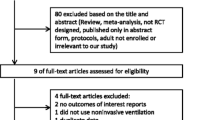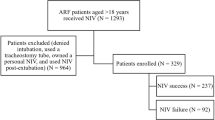Abstract
Purpose
Single studies of Noninvasive Ventilation (NIV) in the management of acute respiratory failure in chest trauma patients have produced controversial findings. The aim of this study is to critically review the literature to investigate whether NIV reduces mortality, intubation rate, length of stay and complications in patients with chest trauma, compared to standard therapy.
Methods
We performed a systematic review and meta-analysis of randomized controlled trials, prospective and retrospective observational studies, by searching PubMed, EMBASE and bibliographies of articles retrieved. We screened for relevance studies that enrolled adults with chest trauma who developed mild to severe acute respiratory failure and were treated with NIV. We included studies reporting at least one clinical outcome of interest to perform a meta-analysis.
Results
Ten studies (368 patients) met the inclusion criteria and were included for the meta-analysis. Five studies (219 patients) reported mortality and results were quite homogeneous across studies, with a summary relative risk for patients treated with NIV compared with standard care (oxygen therapy and invasive mechanical ventilation) of 0.26 (95 % confidence interval 0.09–0.71, p = 0.003). There was no advantage in mortality of continuous positive airway pressure over noninvasive pressure support ventilation. NIV significantly increased arterial oxygenation and was associated with a significant reduction in intubation rate, in the incidence of overall complications and infections.
Conclusions
These results suggest that NIV could be useful in the management of acute respiratory failure due to chest trauma.



Similar content being viewed by others
Explore related subjects
Discover the latest articles and news from researchers in related subjects, suggested using machine learning.References
Pinilla JC (1982) Acute respiratory failure in severe blunt chest trauma. J Trauma 22:221–226
Clark GC, Schecter WP, Trunkey DD (1988) Variables affecting outcome in blunt chest trauma: flail chest vs. pulmonary contusion. J Trauma 28:298–304
LoCicero J III, Mattox KL (1989) Epidemiology of chest trauma. Surg Clin North Am 69:15–19
Shorr RM, Crittenden M, Indeck M et al (1987) Blunt thoracic trauma. Analysis of 515 patients. Ann Surg 206:200–205
Wanek S, Mayberry JC (2004) Blunt thoracic trauma: flail chest, pulmonary contusion, and blast injury. Crit Care Clin 20:71–81
Ziegler DW, Agarwal NN (1994) The morbidity and mortality of rib fractures. J Trauma 37:975–979
Becher RD, Colonna AL, Enniss TM et al (2012) An innovative approach to predict the development of adult respiratory distress syndrome in patients with blunt trauma. J Trauma Acute Care Surg 73:1229–1235
Martin M, Salim A, Murray J et al (2005) The decreasing incidence and mortality of acute respiratory distress syndrome after injury: a 5-year observational study. J Trauma 59:1107–1113
Hudson LD, Milberg JA, Anardi D et al (1995) Clinical risks for development of the acute respiratory distress syndrome. Am J Respir Crit Care Med 151:293–301
Navarrete-Navarro P, Rodriguez A, Reynolds N et al (2001) Acute respiratory distress syndrome among trauma patients: trends in ICU mortality, risk factors, complications and resource utilization. Intensive Care Med 27:1133–1140
Treggiari MM, Hudson LD, Martin DP et al (2004) Effect of acute lung injury and acute respiratory distress syndrome on outcome in critically ill trauma patients. Crit Care Med 32:327–331
Salim A, Martin M, Constantinou C et al (2006) Acute respiratory distress syndrome in the trauma intensive care unit: morbid but not mortal. Arch Surg 141:655–658
DuBose JJ, Putty B, Teixeira PG et al (2011) The relationship between post-traumatic ventilator-associated pneumonia outcomes and American College of Surgeons trauma centre designation. Injury 42:40–43
Karmakar MK, Ho AM (2003) Acute pain management of patients with multiple fractured ribs. J Trauma 54:615–625
Trinkle JK, Richardson JD, Franz JL et al (1975) Management of flail chest without mechanical ventilation. Ann Thorac Surg 19:355–363
Rico FR, Cheng JD, Gestring ML et al (2007) Mechanical ventilation strategies in massive chest trauma. Crit Care Clin 23:299–315 xi
Johnson JA, Cogbill TH, Winga ER (1986) Determinants of outcome after pulmonary contusion. J Trauma 26:695–697
Richardson JD, Adams L, Flint LM (1982) Selective management of flail chest and pulmonary contusion. Ann Surg 196:481–487
Antonelli M, Conti G, Riccioni L et al (1996) Noninvasive positive-pressure ventilation via face mask during bronchoscopy with BAL in high-risk hypoxemic patients. Chest 110:724–728
Antonelli M, Conti G, Moro ML et al (2001) Predictors of failure of noninvasive positive pressure ventilation in patients with acute hypoxemic respiratory failure: a multi-center study. Intensive Care Med 27:1718–1728
Mariani J, Macchia A, Belziti C et al (2011) Noninvasive ventilation in acute cardiogenic pulmonary edema: a meta-analysis of randomized controlled trials. J Card Fail 17:850–859
Peter JV, Moran JL, Phillips-Hughes J et al (2006) Effect of non-invasive positive pressure ventilation (NIPPV) on mortality in patients with acute cardiogenic pulmonary oedema: a meta-analysis. Lancet 367:1155–1163
Lightowler JV, Wedzicha JA, Elliott MW et al (2003) Non-invasive positive pressure ventilation to treat respiratory failure resulting from exacerbations of chronic obstructive pulmonary disease: cochrane systematic review and meta-analysis. BMJ 326:185
Keenan SP, Sinuff T, Cook DJ et al (2004) Does noninvasive positive pressure ventilation improve outcome in acute hypoxemic respiratory failure? A systematic review. Crit Care Med 32:2516–2523
Antonelli M, Conti G, Rocco M et al (1998) A comparison of noninvasive positive-pressure ventilation and conventional mechanical ventilation in patients with acute respiratory failure. N Engl J Med 339:429–435
Nourdine K, Combes P, Carton MJ et al (1999) Does noninvasive ventilation reduce the ICU nosocomial infection risk? A prospective clinical survey. Intensive Care Med 25:567–573
Nava S, Hill N (2009) Non-invasive ventilation in acute respiratory failure. Lancet 374:250–259
Uretzky G, Cotev S (1980) The use of continuous positive airway pressure in blast injury of the chest. Crit Care Med 8:486–489
BTS Standards of Care Committee (2002) Non-invasive ventilation in acute respiratory failure. Thorax 57:192–211
Egger M, Smith GD, Altman D (2001) Systematic reviews in health care: meta-analysis in context. BMJ Publishing Group, London
Rothman KJ, Greenland S (2008) Modern epidemiology, 3rd edn. Lippincott Williams & Wilkins, Philadelphia
Higgins JP, Thompson SG (2002) Quantifying heterogeneity in a meta-analysis. Stat Med 21:1539–1558
Beltrame F, Lucangelo U, Gregori D et al (1999) Noninvasive positive pressure ventilation in trauma patients with acute respiratory failure. Monaldi Arch Chest Dis 54:109–114
Gregoretti C, Beltrame F, Lucangelo U et al (1998) Physiologic evaluation of non-invasive pressure support ventilation in trauma patients with acute respiratory failure. Intensive Care Med 24:785–790
Ferrer M, Esquinas A, Leon M et al (2003) Noninvasive ventilation in severe hypoxemic respiratory failure: a randomized clinical trial. Am J Respir Crit Care Med 168:1438–1444
Hernandez G, Fernandez R, Lopez-Reina P et al (2010) Noninvasive ventilation reduces intubation in chest trauma-related hypoxemia: a randomized clinical trial. Chest 137:74–80
Xirouchaki N, Kondoudaki E, Anastasaki M et al (2005) Noninvasive bilevel positive pressure ventilation in patients with blunt thoracic trauma. Respiration 72:517–522
Bolliger CT, Van Eeden SF (1990) Treatment of multiple rib fractures. Randomized controlled trial comparing ventilatory with nonventilatory management. Chest 97:943–948
Linton DM, Potgieter PD (1982) Conservative management of blunt chest trauma. S Afr Med J 61:917–919
Gunduz M, Unlugenc H, Ozalevli M et al (2005) A comparative study of continuous positive airway pressure (CPAP) and intermittent positive pressure ventilation (IPPV) in patients with flail chest. Emerg Med J 22:325–329
Vidhani K, Kause J, Parr M (2002) Should we follow ATLS guidelines for the management of traumatic pulmonary contusion: the role of non-invasive ventilatory support. Resuscitation 52:265–268
Hurst JM, DeHaven CB, Branson RD (1985) Use of CPAP mask as the sole mode of ventilatory support in trauma patients with mild to moderate respiratory insufficiency. J Trauma 25:1065–1068
Munshi IA, DeHaven B, Kirton O et al (1999) Reengineering respiratory support following extubation: avoidance of critical care unit costs. Chest 116:1025–1028
Papadakos PJ, Karcz M, Lachmann B (2010) Mechanical ventilation in trauma. Curr Opin Anaesthesiol 23:228–232
Christensson P, Gisselsson L, Lecerof H et al (1979) Early and late results of controlled ventilation in flail chest. Chest 75:456–460
Diethelm AG, Battle W (1971) Management of flail chest injury: a review of 75 cases. Am Surg 37:667–670
Chiumello D, Esquinas AM, Moerer O et al (2012) A systematic technical review of the systems for the continuous positive airway pressure. Minerva Anestesiol 78:1385–1393
Sferrazza Papa GF, Di Marco F, Akoumianaki E et al (2012) Recent advances in interfaces for non-invasive ventilation: from bench studies to practical issues. Minerva Anestesiol 78:1146–1153
Pisani L, Carlucci A, Nava S (2012) Interfaces for noninvasive mechanical ventilation: technical aspects and efficiency. Minerva Anestesiol 78:1154–1161
Jaber S, Jung B (2011) Postoperative non-invasive ventilation outside the ICU: do not go too far! Minerva Anestesiol 77:9–10
Antonelli M, Moro ML, Capelli O et al (1994) Risk factors for early onset pneumonia in trauma patients. Chest 105:224–228
Masip J, Roque M, Sanchez B et al (2005) Noninvasive ventilation in acute cardiogenic pulmonary edema: systematic review and meta-analysis. JAMA 294:3124–3130
Agarwal R, Aggarwal AN, Gupta D (2010) Role of noninvasive ventilation in acute lung injury/acute respiratory distress syndrome: a proportion meta-analysis. Respir Care 55:1653–1660
Nava S, Schreiber A, Domenighetti G (2011) Noninvasive ventilation for patients with acute lung injury or acute respiratory distress syndrome. Respir Care 56:1583–1588
Chiumello D, Pelosi P, Carlesso E et al (2003) Noninvasive positive pressure ventilation delivered by helmet vs. standard face mask. Intensive Care Med 29:1671–1679
Tyburski JG, Collinge JD, Wilson RF et al (1999) Pulmonary contusions: quantifying the lesions on chest X-ray films and the factors affecting prognosis. J Trauma 46:833–838
Peter JV, Moran JL, Phillips-Hughes J et al (2002) Noninvasive ventilation in acute respiratory failure—a meta-analysis update. Crit Care Med 30:555–562
Joshi N, Localio AR, Hamory BH (1992) A predictive risk index for nosocomial pneumonia in the intensive care unit. Am J Med 93:135–142
Tejada AA, Bello DS, Chacon VE et al (2001) Risk factors for nosocomial pneumonia in critically ill trauma patients. Crit Care Med 29:304–309
Agarwal R, Aggarwal AN, Gupta D et al (2005) Non-invasive ventilation in acute cardiogenic pulmonary oedema. Postgrad Med J 81:637–643
Conflicts of interest
Dr. Gregoretti received fees for lectures from Vivisol, SapoLife and Covidien. He also received fees for consultancies from Covidien and Smith Medical.
Author information
Authors and Affiliations
Corresponding author
Rights and permissions
About this article
Cite this article
Chiumello, D., Coppola, S., Froio, S. et al. Noninvasive ventilation in chest trauma: systematic review and meta-analysis. Intensive Care Med 39, 1171–1180 (2013). https://doi.org/10.1007/s00134-013-2901-4
Received:
Accepted:
Published:
Issue Date:
DOI: https://doi.org/10.1007/s00134-013-2901-4




